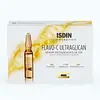What's inside
What's inside
 Key Ingredients
Key Ingredients

 Benefits
Benefits

 Concerns
Concerns

 Ingredients Side-by-side
Ingredients Side-by-side

Snail Secretion Filtrate
Skin ConditioningPropylene Glycol
HumectantWater
Skin ConditioningSaccharide Isomerate
HumectantHexylene Glycol
EmulsifyingPolysorbate 20
EmulsifyingPEG/PPG-20/6 Dimethicone
EmulsifyingSodium Ascorbyl Phosphate
AntioxidantSodium Chloride
MaskingTocopheryl Acetate
AntioxidantUrea
BufferingFructose
HumectantGlucose
HumectantAspartic Acid
MaskingGlutamic Acid
HumectantParfum
MaskingPolyquaternium-10
Citric Acid
BufferingTetrasodium EDTA
Dextrin
AbsorbentSucrose
HumectantAlanine
MaskingHexyl Nicotinate
EmollientHydroxycitronellal
PerfumingCoumarin
PerfumingGeraniol
PerfumingLinalool
PerfumingHexyl Cinnamal
PerfumingLimonene
PerfumingSnail Secretion Filtrate, Propylene Glycol, Water, Saccharide Isomerate, Hexylene Glycol, Polysorbate 20, PEG/PPG-20/6 Dimethicone, Sodium Ascorbyl Phosphate, Sodium Chloride, Tocopheryl Acetate, Urea, Fructose, Glucose, Aspartic Acid, Glutamic Acid, Parfum, Polyquaternium-10, Citric Acid, Tetrasodium EDTA, Dextrin, Sucrose, Alanine, Hexyl Nicotinate, Hydroxycitronellal, Coumarin, Geraniol, Linalool, Hexyl Cinnamal, Limonene
Propylene Glycol
HumectantWater
Skin ConditioningAscorbic Acid
AntioxidantBis-Hydroxyethoxypropyl Dimethicone
EmollientGlycerin
HumectantPPG-26-Buteth-26
Skin ConditioningTocopherol
AntioxidantPEG-40 Hydrogenated Castor Oil
EmulsifyingParfum
MaskingSodium Benzoate
MaskingHydrogenated Soybean Oil
EmollientButylene Glycol
HumectantPotassium Sorbate
PreservativeHydrolyzed Hyaluronic Acid
HumectantSodium Hydroxide
BufferingTetradecyl Aminobutyroylvalylaminobutyric Urea Trifluoroacetate
Skin ConditioningPhenoxyethanol
PreservativeSoluble Proteoglycan
Skin ConditioningMagnesium Chloride
Ergothioneine
AntioxidantPropylene Glycol, Water, Ascorbic Acid, Bis-Hydroxyethoxypropyl Dimethicone, Glycerin, PPG-26-Buteth-26, Tocopherol, PEG-40 Hydrogenated Castor Oil, Parfum, Sodium Benzoate, Hydrogenated Soybean Oil, Butylene Glycol, Potassium Sorbate, Hydrolyzed Hyaluronic Acid, Sodium Hydroxide, Tetradecyl Aminobutyroylvalylaminobutyric Urea Trifluoroacetate, Phenoxyethanol, Soluble Proteoglycan, Magnesium Chloride, Ergothioneine
Alternatives
Ingredients Explained
These ingredients are found in both products.
Ingredients higher up in an ingredient list are typically present in a larger amount.
Parfum is a catch-all term for an ingredient or more that is used to give a scent to products.
Also called "fragrance", this ingredient can be a blend of hundreds of chemicals or plant oils. This means every product with "fragrance" or "parfum" in the ingredients list is a different mixture.
For instance, Habanolide is a proprietary trade name for a specific aroma chemical. When used as a fragrance ingredient in cosmetics, most aroma chemicals fall under the broad labeling category of “FRAGRANCE” or “PARFUM” according to EU and US regulations.
The term 'parfum' or 'fragrance' is not regulated in many countries. In many cases, it is up to the brand to define this term.
For instance, many brands choose to label themselves as "fragrance-free" because they are not using synthetic fragrances. However, their products may still contain ingredients such as essential oils that are considered a fragrance by INCI standards.
One example is Calendula flower extract. Calendula is an essential oil that still imparts a scent or 'fragrance'.
Depending on the blend, the ingredients in the mixture can cause allergies and sensitivities on the skin. Some ingredients that are known EU allergens include linalool and citronellol.
Parfum can also be used to mask or cover an unpleasant scent.
The bottom line is: not all fragrances/parfum/ingredients are created equally. If you are worried about fragrances, we recommend taking a closer look at an ingredient. And of course, we always recommend speaking with a professional.
Learn more about ParfumPropylene Glycol is an odorless, colorless liquid. As a humectant, it helps skin retain moisture. It also aids in delivering active ingredients.
Another role of this ingredient is preventing a product from melting or freezing. Propylene glycol also adds antimicrobrial properties to a product, elongating product lifespan.
This ingredient is considered an organic alcohol and commonly added into both cosmetics and foods.
Those with sensitive skin or conditions may develop a rash when using this ingredient.
Learn more about Propylene GlycolWater. It's the most common cosmetic ingredient of all. You'll usually see it at the top of ingredient lists, meaning that it makes up the largest part of the product.
So why is it so popular? Water most often acts as a solvent - this means that it helps dissolve other ingredients into the formulation.
You'll also recognize water as that liquid we all need to stay alive. If you see this, drink a glass of water. Stay hydrated!
Learn more about Water